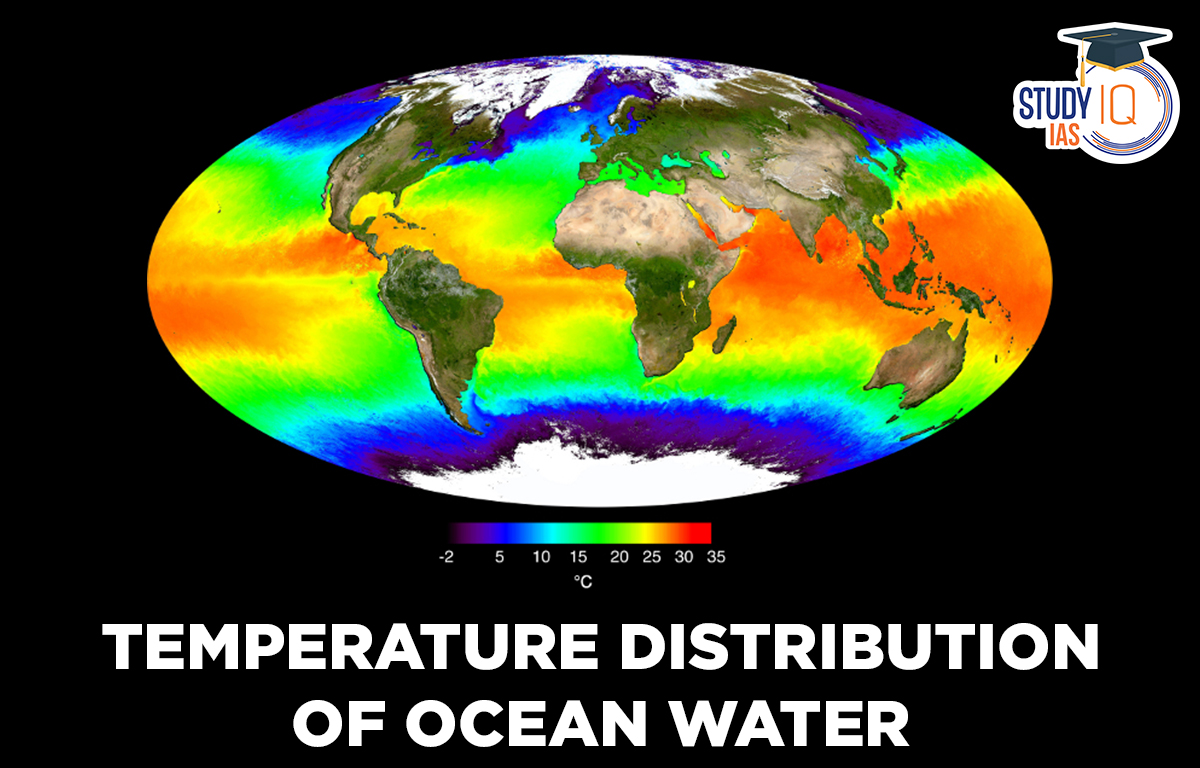Table of Contents
Temperature Distribution of Ocean Water
The temperature of the ocean is important for marine organisms such as plants (phytoplanktons) and animals (zooplankton). The temperature of seawater influences the climate of coastal lands, as well as the plants and animals that live there. It is important to study both surface and subsurface seawater temperatures. Surface temperature is measured with standard thermometers, while subsurface temperature uses reversing thermometers and thermographs. The Sun heats the oceans, and because seawater holds heat better than land, it heats up and cools down more slowly. Oceans can store a lot of heat.
Read More: Atlantic Ocean
Ocean Water Temperature Sources
Two major sources of ocean temperature are as follows:
- The Sun heats the water, and the temperature is diffused or reached depth due to convection.
- Bottom water receives heat from volcanic activity along oceanic ridges.
Read More: Major Ocean Relief Features
Temperature Distribution of Ocean Water Influencing Factors
The Temperature Distribution of Ocean Water is influenced by several factors, including:
Latitude: As the amount of insolation decreases from the equator to the poles, the temperature of the surface water decreases as well.
Uneven Distribution of Land and Water: The northern hemisphere’s oceans receive more heat due to their contact with a larger area of land than their southern hemisphere counterparts. As a result, the temperature of surface water is higher in the northern hemisphere than in the southern hemisphere.
Prevailing Wind: Winds blowing from the land towards the oceans/sea (offshore winds) drive warm surface water away from the coast, causing cold bottom water from below to upwell.
This causes temperature variations along the way. On the contrary, onshore winds (which blow from the ocean to land) accumulate warm water near the coast, raising the temperature.
Ocean Currents: Warm currents raise the temperature of the affected areas, while cool currents lower the temperature. The Gulf Stream (warm current) raises the temperature of eastern North America and Europe’s west coast. The Labrador cool current reduces the temperature near North America’s northeast coast. Siberia’s eastern coast temperature drops due to the Kurile cool current.
Minor factors such as submarine ridges, and local weather conditions such as storms, hurricanes, fog, cloudiness, evaporation, and condensation all have an effect on the surface temperature of the ocean water. In the low latitudes, enclosed seas have higher temperatures than open seas, while in the high latitudes, enclosed seas have lower temperatures than open seas.
Read More: Ocean Waves
Horizontal Temperature Distribution in Oceans
The diurnal and annual temperature ranges of oceans are much smaller than those of land. The average temperature of the ocean’s surface water decreases gradually from the equator to the poles. Temperature usually drops by about 0.5°C for each degree of latitude. For example, at 22° latitude, the average temperature is around 22°C, while at 40° latitude, it’s about 14°C, and near the poles, it’s around 0°C. The hottest temperatures are found just north of the equator, not at the equator itself. Also, ocean temperatures in the northern hemisphere are generally warmer than in the southern hemisphere due to differences in land and water distribution.
The average annual temperature of the northern hemisphere oceans is around 19°C, while the average annual temperature of the southern hemisphere oceans is around 16°C.

Read More: Ocean Tides
Vertical Temperature Distribution in Oceans
The warmest water in the oceans is at the surface because it gets direct sunlight. The oceans are divided into three layers:
Upper Layer: This is the warmest layer, about 500 meters thick, with temperatures between 20°C and 25°C. It exists year-round in tropical areas but only in summer at mid-latitudes.
Thermocline Layer (Second Layer): Below the upper layer, temperatures drop quickly with depth. This layer is 500-1000 meters thick, and about 90% of the ocean’s water lies beneath it, where temperatures are near freezing.
Lower Layer: This layer is very cold and reaches the ocean floor. In the Arctic and Antarctic, temperature changes are minimal because surface water is also close to 0°C.

Read More: Ocean Deposits
Temperature Distribution of Ocean Water UPSC
The water warms up more slowly than air but can hold more heat because water requires four times as much energy to raise its temperature by one degree Celsius as the same mass of the air, so the ocean plays an important role in absorbing energy from the Sun and preventing the Earth from becoming too hot.
Read about: Indian Ocean Dipole


 Role of Teachers in Educations, Student ...
Role of Teachers in Educations, Student ...
 India's achievements after 75 years of I...
India's achievements after 75 years of I...
 Bal Gangadhar Tilak Biography, Achieveme...
Bal Gangadhar Tilak Biography, Achieveme...

























